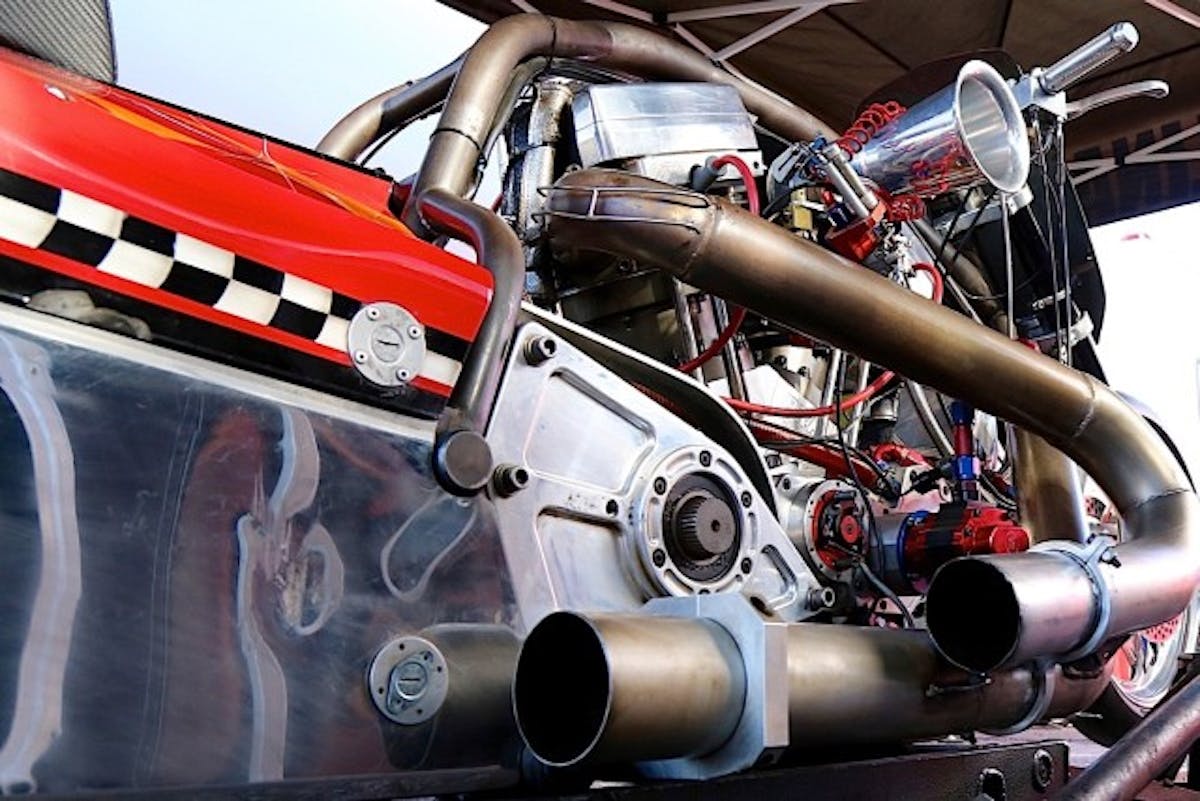 There are some similarities, but there are also plenty of differences between the engines in the Top Fuel Harley motorcycles and the Top Fuel dragsters that run at NHRA events.
There are some similarities, but there are also plenty of differences between the engines in the Top Fuel Harley motorcycles and the Top Fuel dragsters that run at NHRA events.
“These are almost all custom engines anymore,” says Mike Bahnmaier, owner of a 3-bike stable who was prepping a ride for Tommy Grimes at the recent Phoenix race. “I don’t know if there’s anything that’s actually Harley on them, other than the cam design. These are side-by-side motors.”
Bahnmaier was referring to the traditional Harley architecture with the two cylinders directly opposed each other at 45-degree angle. This arrangement is achieved by using male and female connecting rods. The female rod is forked at the big end, allowing the male rode to be positioned between the forks and keeping the beam or body of the rods directly inline with each other. Also, early Top Fuel Harleys ran with 5-piece crankshafts.
“You could only get them into the high 6s in quarter mile, and things started moving so bad on the crank it would take the rods out,” explains Bahnmaier, noting that he runs 50W oil at 90 psi.
The nitro Harley engines are also feature a 45-degree bank but run a single-pin PRP billet crankshaft, resulting in offset cylinders with conventional 8.5-inch automotive-style rods mounted side-by-side on the crank’s rod journal.
With displacements ranging from 175ci up to the maximum allowable 200ci, many engines will have an undersquare bore and storke. Bahnmaier’s 189ci engine featured a 4.790-inch bore and 5.25-inch stroke.
“We can go up to 4.800 with these particular cylinders and they’ll be done,” says Bahnmaier.
The cylinder heads and crankcase are also billet aluminum but the cylinders are steel. Compression ratio ranges from 11:1 up to 12:1, with Bahnmaier running 11.2:1. He also sets up his cylinder heads with 2.50-inch titanium intake valves and 2.100 Inconel exhaust valves. Valve lift is in the .800-inch range.
“Just like a Top Fuel engine, it’s tough to open the exhaust valve with all the cylinder pressure,” says Bahnmaier. “We know we’re getting a lot of flex on the exhaust pushrod.”
Teams can run straight 100 percent nitromethane. Bahnmaier starts at 96 percent.
“If the air gets worse, rather than changing the fuel curve or nozzles, I just bump up the nitro mix,” he adds.
The engine will slurp about 1.75 gallons during the burnout and run. Fuel is sent to a 16-gallon-per-minute pump, and the fuel curve is controlled with slide valve, just like the Top Fuel cars. Plenty of fuel is delivered at the start when the engine surges to around 4,100 to 4,300 rpm. The same control box that manipulates the slide valve also shifts the 2-speed transmission (1.28:1 low gear) at a predetermined time. The system then starts bleeding off fuel as the 3-stage clutch completes locks up and load on the engine decreases past mid track. Through the lights the engine is running about 4,800 to 4,900 rpm.
Fuel is delivered via two constant-flow nozzles per cylinder. A barrel valve controls idle speed. Air is controlled through a 2.75-inch throttle blade on each cylinder, which sports a pair of spark plugs fired through an MSD Harley Nitro ignition and four coils. Most teams run around 46 to 50 degrees timing during the run.
“It’s hard to dyno these on a chassis dyno,” says Bahnmaier, “but we think they’re running 950 to 1,000 horsepower.”

You might also like
SEMA 2025: New SPC Iron Block Lineup From Summit Racing
Summit Racing's new SPC line of iron blocks are perfect for street, performance, or competition engine builds.


